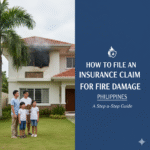How to Claim Insurance After Car Accident Philippines
If you just had a crash and you’re wondering How to Claim Insurance After Car Accident Philippines, this guide walks you through the exact steps to take — from the roadside to claim settlement — so you don’t miss crucial evidence or deadlines.
Knowing How to Claim Insurance After Car Accident Philippines ahead of time helps you act calmly: what to photograph, which reports to secure, and exactly who to contact at your insurer.
Follow these plain-language steps. Doing How to Claim Insurance After Car Accident Philippines correctly the first time shortens processing time and reduces the chance of denial.
At the scene: first 10 minutes (what to do immediately)
-
Safety first. Move to a safe place if the vehicle is driveable. Attend to injuries, call emergency services (911/PNP/ambulance) if needed.
-
Call the police / traffic enforcers. Get an accident report or blotter from the responding authority — this is often required by insurers and is essential evidence. MoneyMax
-
Document everything. Take clear photos of damage, license plates, the surrounding scene, road signs, skid marks, and the other vehicle’s OR/CR and driver’s license. Note date, time, location, and witness names.
-
Exchange details. Get names, phone numbers, plate numbers, insurance company and policy number (if available). Don’t admit fault on the spot — stick to facts.
What to know about CTPL vs comprehensive coverage
All vehicles in the Philippines must have Compulsory Third Party Liability (CTPL) insurance for registration; CTPL covers third-party bodily injury or death up to the legal limit (standard policies note a per-occurrence cap). Comprehensive policies add cover for your vehicle (own damage), theft, fire, and personal accident benefits. If the other driver only has CTPL, your own vehicle damage may only be covered if you have comprehensive insurance. BDO Philippines+1
Documents you’ll typically need to file a motor claim
Prepare clear copies (scan or photo) of:
-
Claim form (your insurer’s form, fully filled)
-
Police report / Incident report / Notarized affidavit if police were not able to come
-
Policy contract / Policy schedule and official receipt of premium (OR)
-
Vehicle OR/CR, driver’s license (yours and the other party’s)
-
Photos of damage / scene / plates / injuries
-
Repair estimate / mechanic’s estimate from authorized shops (if requested)
-
Medical certificates, hospital bills (if injury claim)
A typical insurer checklist matches the above — collect them as early as possible to avoid delays. philbritish.com+1
Step-by-step claims process (what to expect)
-
Notify your insurer immediately. Call the insurer’s claims hotline and your agent, and ask for the claims reference number and the next steps. Early notification is critical. Moneymax
-
Submit documents. Send scans/photos by email or the insurer’s online portal; keep originals.
-
Vehicle assessment / Adjuster visit. An adjuster may inspect the vehicle to verify damage and liability — cooperate and provide requested records. RESPICIO & CO.
-
Liability determination. Insurer evaluates fault and coverage (CTPL vs comprehensive) and calculates payable amount.
-
Settlement or repair authorization. For comprehensive claims, insurers often provide a list of accredited shops or authorize cash settlement/repair. For third-party bodily injury claims, they will ask for medical documents and may negotiate compensation.
-
If denied or disputed. If you believe the insurer wrongly denied or delayed your claim, you can escalate — see the Insurance Commission’s complaint/assistance process below. Philippine Insurance Commission
Typical timelines & tips to speed up the claim
-
Notify insurer on the same day (or within insurer’s stated reporting window). Delays can be used as grounds for denial. Moneymax
-
Submit complete documents the first time — missing docs are the most common cause of hold-ups. philbritish.com
-
Be proactive with the adjuster — provide clear photos, estimates, and receipts so assessment moves faster. RESPICIO & CO.
Common reasons claims get delayed or denied
-
Late notification of loss
-
Incomplete or unsigned claim forms
-
Evidence of misrepresentation (wrong facts)
-
Driving under influence, using vehicle for unlawful activity, or not having valid CTPL/registration at time of accident
-
Dispute over who is at fault


